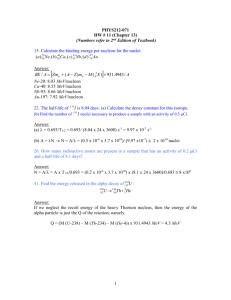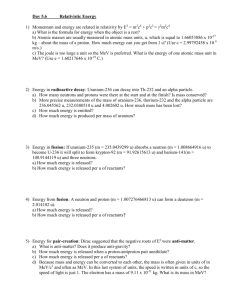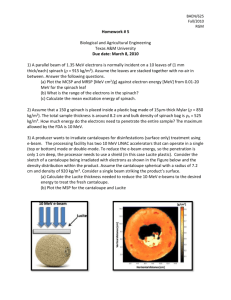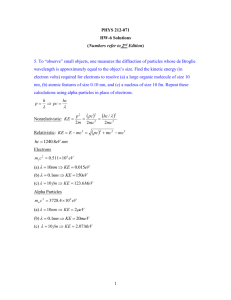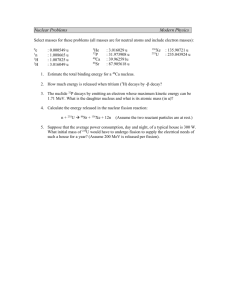Physics 161 Homework 5 - Solutions Monday October 17, 2011
advertisement
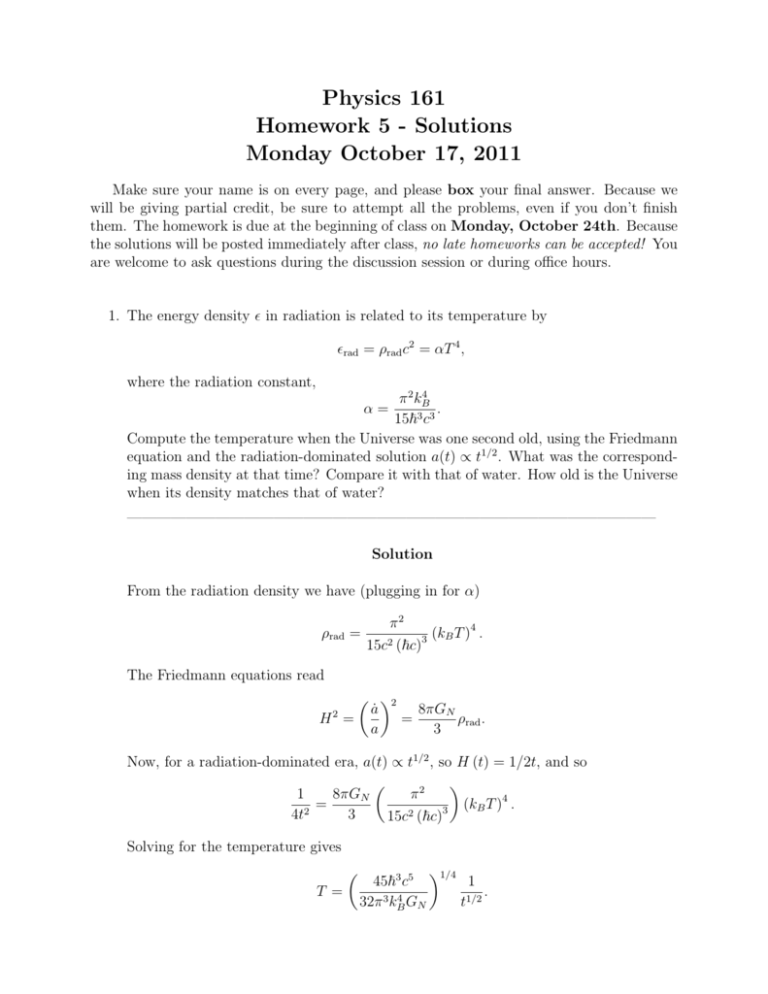
Physics 161 Homework 5 - Solutions Monday October 17, 2011 Make sure your name is on every page, and please box your final answer. Because we will be giving partial credit, be sure to attempt all the problems, even if you don’t finish them. The homework is due at the beginning of class on Monday, October 24th. Because the solutions will be posted immediately after class, no late homeworks can be accepted! You are welcome to ask questions during the discussion session or during office hours. 1. The energy density in radiation is related to its temperature by rad = ρrad c2 = αT 4 , where the radiation constant, 4 π 2 kB . 15~3 c3 Compute the temperature when the Universe was one second old, using the Friedmann equation and the radiation-dominated solution a(t) ∝ t1/2 . What was the corresponding mass density at that time? Compare it with that of water. How old is the Universe when its density matches that of water? α= ———————————————————————————————————— Solution From the radiation density we have (plugging in for α) ρrad = π2 4 3 (kB T ) . 2 15c (~c) The Friedmann equations read 2 ȧ 8πGN H = = ρrad . a 3 2 Now, for a radiation-dominated era, a(t) ∝ t1/2 , so H (t) = 1/2t, and so 1 8πGN π2 = (kB T )4 . 3 2 2 4t 3 15c (~c) Solving for the temperature gives T = 45~3 c5 4 32π 3 kB GN 1/4 1 t1/2 . Notice that T ∼ a−1 = t−1/2 , as expected. Now, the term in parenthesis is a constant, and plugging in all the numbers gives 45~3 c5 4 32π 3 kB GN 1/4 √ = 1.518 × 1010 sec Kelvins, and so 10 T = 1.518 × 10 1 sec t 1/2 Kelvins. Hence, at one second, the temperature is 1.518×1010 Kelvins. We could plug this temperature back into the equation for the density, ρrad ∼ T 4 , but an easier way is to note that 3 ρrad = , 32πGN t2 where we have plugged in H 2 = 1/4t2 . Now, a handy number is 8πGN /3 = 5.59×10−10 , and so 4.47 × 108 3 = kg/m3 , ρrad = 32πGN t2 t2 and so at one second ρrad = 4.47 × 108 kg/m3 . The density of water is ρwater = 103 kg/m3 , and so the radiation density is more than ten thousand times bigger! The time when the density was equal to that of water can be found by r 4.47 × 108 ≈ 669 seconds, t= 103 or about 11 minutes. 2. The present number density of electrons in the Universe is the same as that of protons, about 0.2 per cubic meter. Consider a time long before the formation of the microwave background, when the scale factor was one millionth of its present value. What was the number density of electrons then? Given that the electron mass-energy is 0.511 MeV, do you expect electrons to be relativistic or non-relativistic at that time (hint, consider the temperature at this time)? The cross-section for the scattering of photons off electrons is the Thomson crosssection σe = 6.7 × 10−29 m2 . Given that the mean free path (i.e. the typical distance travelled between interactions) of photons through an electron gas of number density ne is d ∼ 1/ne σe , compute the mean free path for photons when the scale factor was one millionth its present value. From the mean free path, calculate the typical time between interactions, the speed of light being c = 3×108 m/s. Compare the interaction time with the age of the Universe at that time, which would be about 10,000 years. What is the significance of the comparison (i.e., is there enough time for the electrons to come to thermal equilibrium)? ———————————————————————————————————— Solution The number density scales as a−3 , so n (t) = n0 a0 a(t) 3 . Now, a0 /a(t) = 106 , so n = n0 106 3 2 × 1017 . = (0.2) × 1018 = meter3 The energy of the electrons due to the background temperature is E ∼ kB T , where the temperature T = T0 (a0 /a) ≈ 3 × 106 Kelvins. So, the energy is E ≈ 3.77 × 10−17 Joules, or 235 eV. Since the mass energy is 0.511 MeV, the energy is much less than the mass-energy of the electrons, so they are non-relativistic. The mean free path d∼ 1 1 = = 7.5 × 1010 meters. 17 σ e ne (2 × 10 ) (6.7 × 10−29 ) The mean time between collisions is t≈ 7.5 × 1010 d = = 280 seconds. c 3 × 108 Since the Universe will have been about 10,000 years old by now, the collision time is much less than the age of the Universe, such that the electrons could interact many, many times and come to thermal equilibrium. 3. At some point back in cosmic time, the Universe was dense enough to be opaque to neutrinos. Then, as the Universe expanded, the density decreased until neutrinos could stream freely. A cosmic neutrino background (which is undetected to date) must have formed when this decoupling between neutrinos and normal matter occurred, in analogy to the CMB that results from the electron-photon decoupling at the time of hydrogen recombination. Find the temperature at which neutrino decoupling occurred. Assume in your calculation that decoupling occurs during the radiation-dominated era, photons pose the main target for neutrinos, neutrinos have an energy-dependent cross section 2 Eν −43 2 , σνγ = 10 cm 1 MeV and the neutrinos are relativistic. Use a k = 0, and ΩΛ = 0 cosmology. Hint: Proceed by requiring that the interaction rate Γ = nγ σνγ vν = H, where nγ is the number density of targets (photons), σ is the above cross section (with Eν = kB T ), v is the speed of the neutrinos, and H is the Hubble parameter. For the number density, take nγ = αT 3 /kB , as in problem 1. Finally determine H in terms of the radiation density using the Friedmann equation. ———————————————————————————————————— Solution The interaction rate is given by nγ σνγ vν = H. Now, because the neutrinos are relativistic, then vν = c. Now, the number density is 2 4 3 3 π kB T π 2 kB T αT 3 = = . nγ = kB 15 ~c 15 (~c)3 kB Now, noting that ~c = 1970 eV Å, which is the same as ~c = 1.97 × 10−11 MeV cm, then 3 3 3 3 π2 1011 kB T 8.63 × 1031 kB T π 2 kB T nγ = = = . 15 ~c 15 1.97 cm 1 MeV cm3 1 MeV Next, −43 σνγ = 10 2 cm kB T 1 MeV 3 , giving 8.63 × 1031 × 10−43 × 3 × 1010 Γ = nγ σνγ c = sec where we have plugged in c = 3 × 1010 cm/sec. kB T 1 MeV 5 0.259 = sec kB T 1 MeV 5 , Now, the Friedmann equation tells us that (for radiation-domination) 8πGN ρrad . 3 H2 = But, from problem 1, we have that 4 4 α 4 kB T π 2 ~c 6.66 × 1042 kB T 1 π2 ρrad = 2 T = 2 × ~c × = . c c 15 ~c 15c2 cm4 1 MeV So, altogether we have π 2 ~c 15c2 GN ~ c5 8πGN H = 3 2 6.66 × 1042 cm4 6.66 × 1042 cm4 kB T 1 MeV 4 kB T 1 MeV 4 . But, we can write this as 8π 3 4 H = c 45 2 . Now, the Planck time, r tPl = GN ~ = 5.39 × 10−44 seconds, c5 and so 8π 3 × c4 t2Pl × H = 45 2 6.66 × 1042 cm4 kB T 1 MeV Plugging in the numbers gives 0.0275 H = sec2 2 kB T 1 MeV 4 , meaning that 0.166 H= sec kB T 1 MeV 2 . Setting Γ = H, we have 0.259 sec kB T 1 MeV 5 0.166 = sec kB T 1 MeV 2 Thus, kB T 1 MeV 3 = 0.166 = 0.640. 0.259 Finally, taking the cube root gives kB T = 0.862 ⇒ kB T ≈ 1 MeV. 1 MeV . 4 . 4. The temperature at the core of the Sun is around 107 K. How old was the Universe when it was this hot? Was it matter dominated or radiation dominated at that time? At the CERN collider, typical particle energies are of order of 100 GeV. How old was the Universe when typical particle energies were around this size? What was the temperature at this time? ———————————————————————————————————— Solution The temperature of the Universe during radiation-domination (which lasts for about 10,000 years) is 1.52 × 1010 K , T = t1/2 where the time t is in seconds. Setting T = 107 Kelvins and solving for time t= 1.52 × 1010 107 2 = (1520)2 = 2.31 × 106 seconds, which is about 27 days, or one month. This time is still well-within the radiationdominated era. The energy for a given temperature can be found by multiplying by Boltzmann’s constant, kB = 1.38 × 10−23 , kB T = 2.31 × 10−13 J 1.31 MeV kB (1.52 × 1010 ) = = . 1/2 1/2 t t t1/2 So, the time corresponding to an energy kB T is 2 1.31 MeV t= . kB T For the CERN energies, kB T = 100 GeV, which is 105 MeV, then 2 1.31 t= = 1.72 × 10−10 seconds, 105 which corresponds to a temperature of T = 1.52 × 1010 K (1.72 × 10−10 )1/2 = 1.16 × 1015 Kelvins. 5. (a) By the standards of typical nuclear reactions, the neutron half-life of 614 seconds is extraordinarily long. What would be the consequence for light element production had this half-life instead been tiny (say a microsecond, for example)? (b) Imagine an alternate Universe where the neutron half-life is 100 seconds rather than 614 seconds. Estimate the fraction of the total mass of baryonic matter in the form of helium once nucleosynthesis is over in such a Universe. ———————————————————————————————————— Solution (a) If the half-life of the neutron had been extremely short, then it would have decayed very quickly, and very little would have been trapped in deuterium or helium. So, the vast majority of the constituents of the Universe would have been hydrogen. In fact, recalling that the ratios 0.2e−t/τ Nn (t) = ≡ r, Np (t) 1.20 − 0.20e−t/τ then taking τ = 10−3 seconds, and the freeze-out temperature t = 300 seconds, we find 0.2e−300000 r= ≡ 0! 1.20 − 0.20e−300000 So, there’s essentially zero neutrons in this Universe! (b) We proceed here as before, now taking τ = 100 seconds and t = 300 seconds, giving 0.2e−3 = 0.0084. r= 1.20 − 0.20e−3 Now, the mass ratio, Y , was found to be Y = 2r 2 (0.0084) = = 0.017, 1+r 1 + 0.0084 which is very much smaller than the observed helium mass fraction of 0.24.


